The Great Lasagna Experiment
I've eaten so much lasagna in the past two weeks for this goddamn newsletter.
I mean don't get me wrong, I did this to myself. I have an old family recipe for a lasagna that only takes ten minutes to prep. I've often thought about posting it online, because I know so many people who love lasagna but feel like it's too hard to make at home. But I knew that if I did that, the "this isn't the right way to make lasagna, this is sacrilege" crowd would come after me hard, and I realized that maybe they would be right to do it! After all, I'd never tried making lasagna the hard, complicated way before.
So I tried making it more complicated. And then I tried making it more complicated. And then I tried making it MORE complicated.
In this newsletter, I'm breaking it down for you, step by step - the easy way, and all the ways you can make it harder. Photos and illustrations by intrepid lasagna taster Shing Yin Khor, whose work you can and should go buy.
(Also, I found out that lasagne is plural for lasagna, but I can't figure out when lasagne becomes a plural. Did I eat a lot of lasagne as in many individual lasagna? Or did I eat a lot of lasagna as in a large single portion of lasagna?? Anyway, whatever. I'm just going to use the singular at all times: all lasagna is part of the Great All-Lasagna.)
If you don't feel like reading all the process stuff and the breakdown of how and why to do everything, just scroll to the bottom, where you'll find the ten-minute-prep recipe waiting for you.
Okay. Let's make a lasagna.
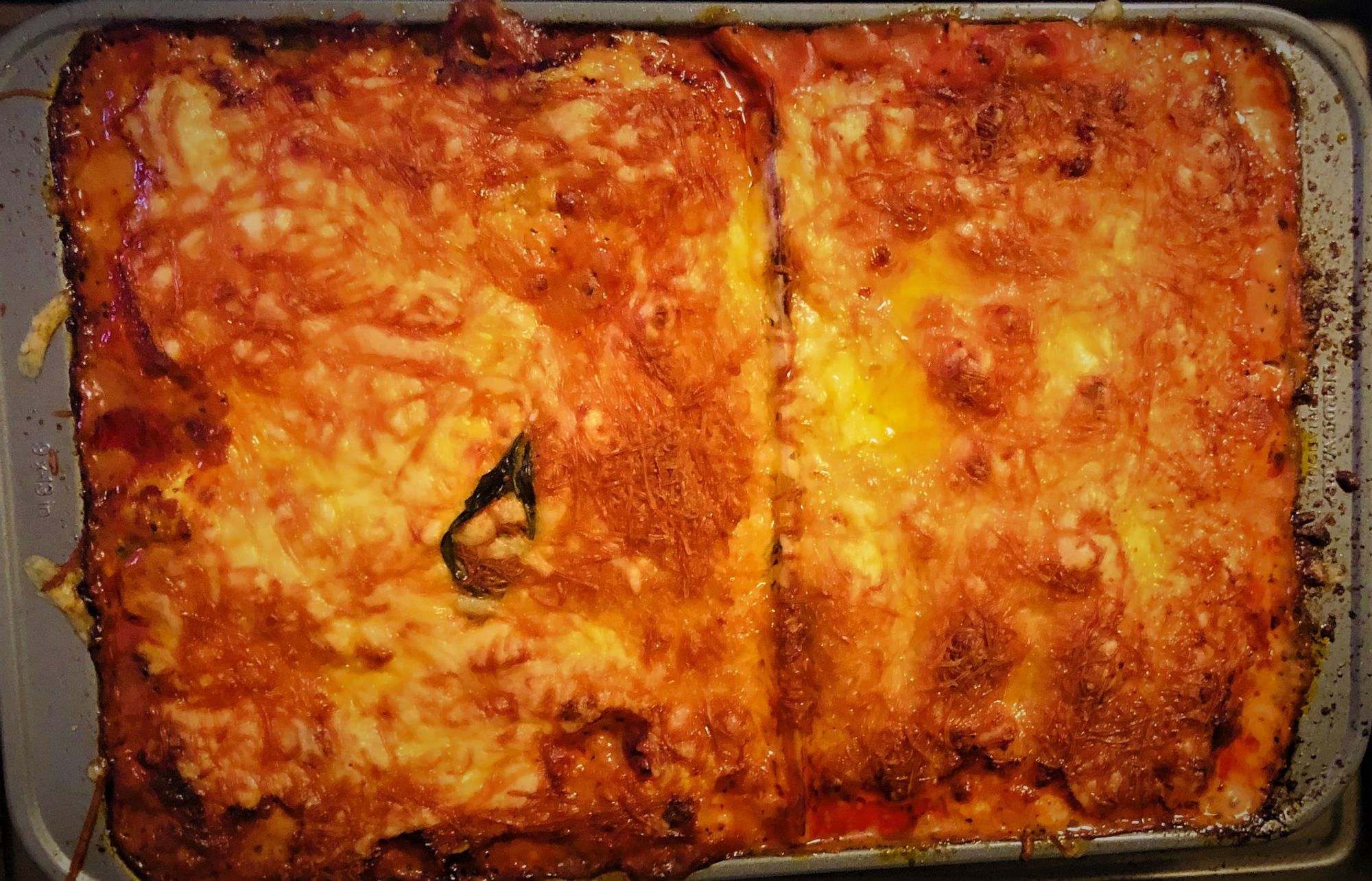
At it's core, a typical modern lasagna is made up of four to five main components: noodles, sauce, cheese, other kind of cheese, and Stuff.
These are all vectors by which you can make a simple lasagna more complicated. You can change up how you treat your noodles, how you prep your sauce, how you prep your cheese, and what kind of Stuff you add. For purposes of this newsletter (and the Great Lasagna Tasting) I made two types of lasagna in the same pan. I'll outline the differences between the two halves as I go, as well as different ways you can make the complicated half even more complicated than I did, if you feel like doing that for some reason.
No matter what, you'll need a 9"x13" lasagna pan, and you'll need to preheat your oven to 375°F.
Layer one is sauce. Spread a thin layer of it on the bottom of a 9" x 13" pan.
- For Easy Lasagna, use cold sauce right out of the jar, no adulteration required. I like Prego and Classico, but follow your heart. Don't listen to jarred-sauce-haters: it might not knock your socks off, but it's got a good homey flavor that really suits a casserole-style dish like this one.
- To add a little flavor and nuance, put your jarred sauce into a pot on the stove with a few dried herbs (oregano, sage, thyme, and bay are all great for this) and a little red wine. Simmer for fifteen to thirty minutes - the longer you simmer, the more those flavors will come together.
- To add a lot of flavor and nuance, make your own red sauce from scratch. It's not hard and it's fucking delicious. Here's my recipe. It includes meat, but you can substitute chopped mushrooms fairly easily as long as you add a little fat to the pan along with them. This sauce keeps in the freezer for at least a couple of months, so feel free to make a fuckton of it ahead of time to thaw for future lasagnas.
In all of my experimentation, I found that the sauce was where most of the flavor variation in the lasagna came from - most of the other alterations impacted the texture more than the flavor. So, if you're going to pick one thing to do up fancy to try to make this lasagna impressive? Consider making it the sauce.
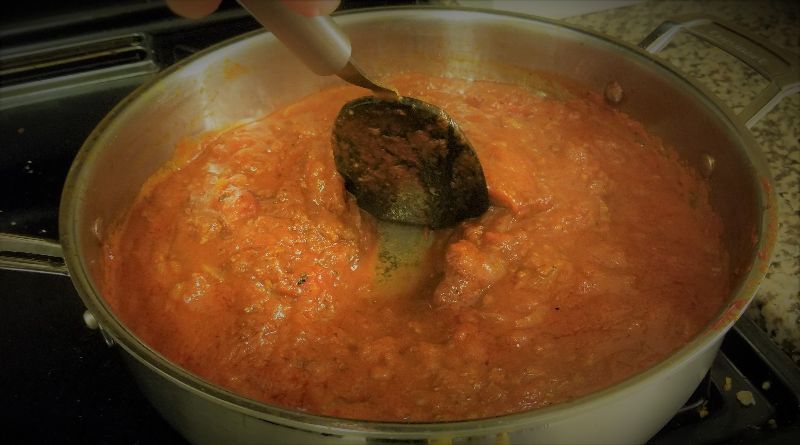
Layer two is noodles. Overlap them slightly.
- For Easy Lasagna, use regular dry noodles - not the ready-to-bake kind, you don't need to stoop that low. Don't cook them ahead of time! There's something coming up that makes it so you don't have to. Trust me. (My noodles didn't quite fit in the pan because I was layering them in sideways so I could do this two-styles-one-pan thing. I have never encountered a single problem from breaking noodles to make them fit. Do what you need to do.)
- You can also make your own pasta if you want! I have no idea how to do this. Yes, I know it can be really easy. You know what else is easy? Cooking with pasta that someone else made for me. If you're going to do this, or if you're going to insist on boiling the noodles ahead of time even though you don't need to, I can't make any guarantees about how the final texture and composition of your lasagna will be impacted.
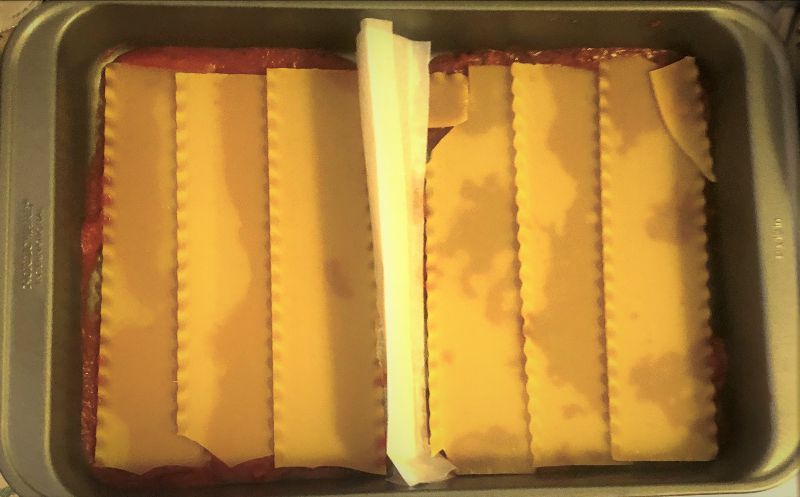
Layer three is another layer of sauce - half of whatever you have remaining. This should almost completely cover the noodles.
Now comes Stuff. If you want to add extra stuff to your lasagna, now's your time. The sauce layer is extremely accommodating, and sandwiching Stuff between the sauce layer and the one that comes on top of it will keep the Stuff stable. The trick is to space out little bits of Stuff so that you don't have one big layer on top of the sauce; if you do that, you run the risk of creating a moisture barrier that will interfere with the cooking process.
Stuff can include:
- Meat! I cook mine into the sauce, but you can do bigger crumbles of sausage or bacon or whatever if you want. Don't do slices of meat that would layer in a similar fashion to the noodles; if you do, you'll wind up with a hard-to-cut, hard-to-eat structure that's eager to slide apart.
- Vegetables! My favorite is spinach, and arugula works nicely too. You can also do squash, or bell peppers if you're living under some kind of curse that requires you to eat them. The thing to watch out for here is moisture; cook your vegetables a bit ahead of time to pull out some of the water in them, otherwise you'll end up with a soupy lasagna.
- Fungus! Mushrooms are a lasagna classic. Again, I prefer cooking them in the sauce, but you don't have to. Also again, cook them a bit ahead of time to draw out moisture.
- Hard-boiled eggs? Apparently? Those and walnuts are ""traditional"" lasagna fillings according to Wikipedia. The world is a terrifying place.
- If your friend is an illustrator, they can make it look like there are little snakes in there. Have you checked out Shing's website yet? No? Do it!
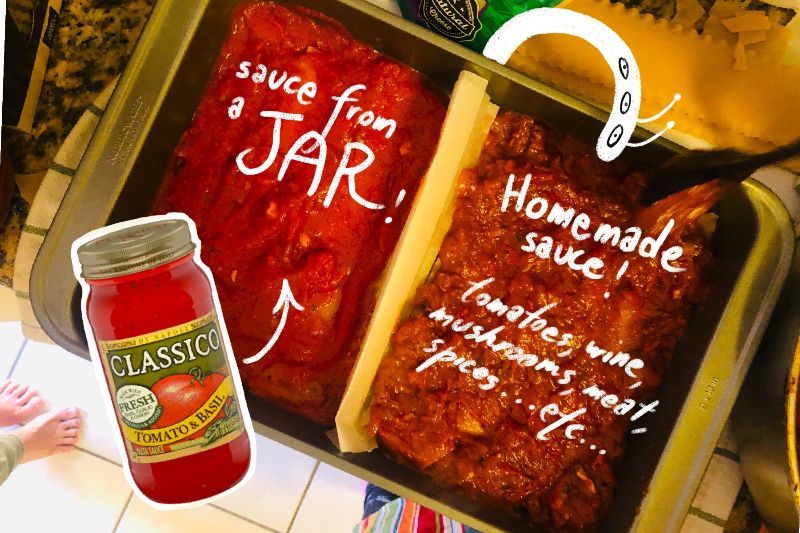
Layer four is a soft cheese.
So, traditionally, you'd use ricotta here. Ricotta is technically a dairy by-product, not a dairy product - you make it from the whey that's left over after you make cheese. (Whey is basically cheese water. I try not to think about it.) The thing is, I fucking hate ricotta. I don't like the grainy texture, which you have to work hard to smooth out, and I find the flavor watery, and none of that changes when ricotta is incorporated into lasagna. I know lots of people like ricotta, but I'm not one of them.
So, here's the ingredient that does the heavy lifting for you in this recipe. Cottage cheese. Full-fat, large- or small-curd cottage cheese. I know, this sounds pretty outlandish, but it works great. The higher moisture content of cottage cheese, which still contains some whey from the curdling process, cooks those dry noodles for you. The curds are softer and creamier, so you don't wind up with any grainy texture on the tongue. The relative sweetness of the cottage cheese cooks right out. Cottage cheese is more stable in the fridge, so your lasagna leftovers are easier to slice than they are when you make this recipe with ricotta. And, if you're a certain kind of person, you may be interested in the fact that cottage cheese has significantly higher protein and significantly lower fat than ricotta does. I don't recommend using low-fat cottage cheese in this or any other situation, life doesn't have to be that way.
Tl;dr: for lasagna, full-fat cottage cheese will render you a silkier, tastier, easier-to-make lasagna. You won't miss ricotta here. I promise.
But if you're some kind of a ricotta enthusiast, do your thing! You can even make your own at home (I will literally never do this). Be aware that ricotta contains quite a lot less moisture than cottage cheese, so you may not be able to pull off the whole dry noodle thing; that trick really rests on the cottage cheese.
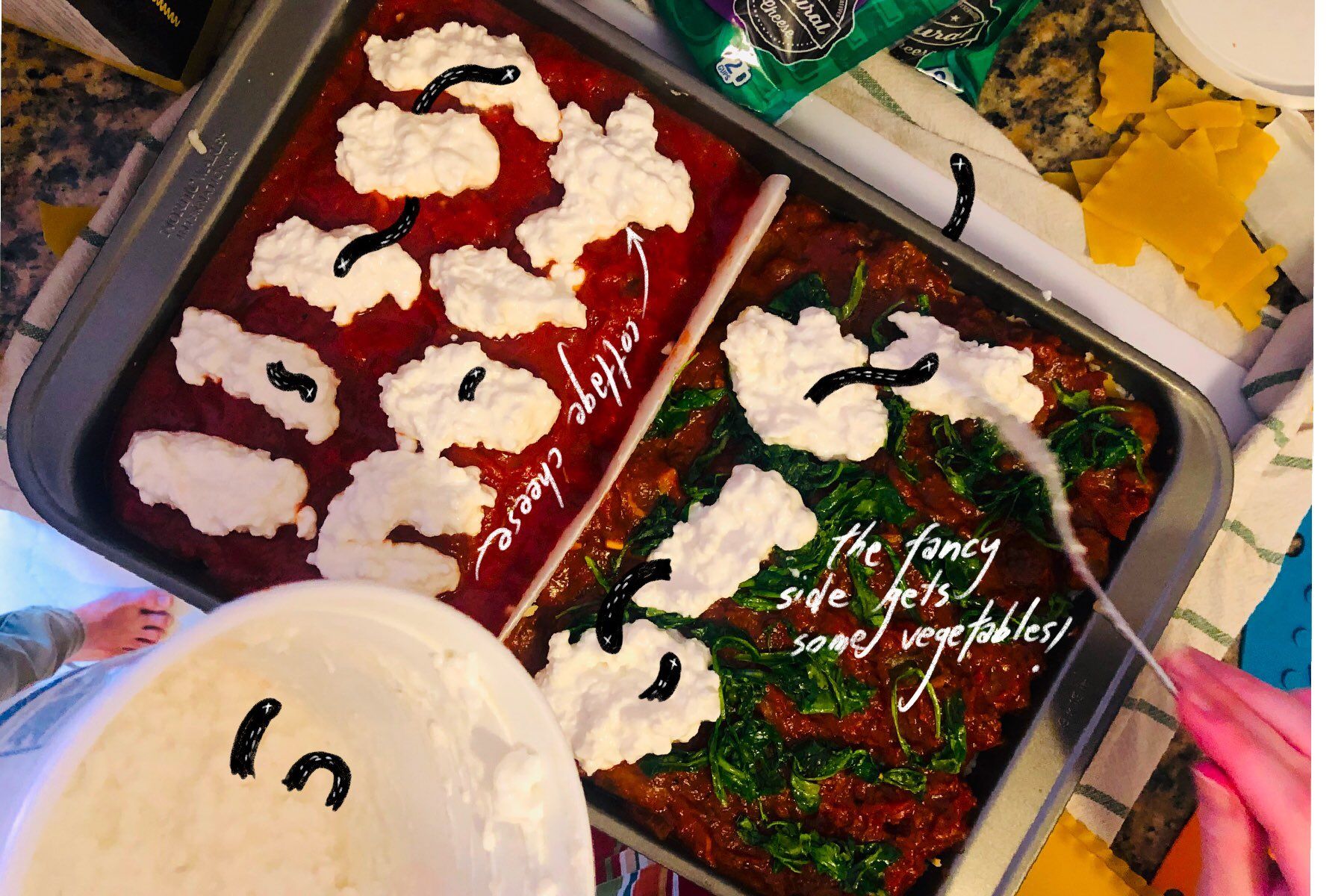
Layer Five is Shredded Cheese. About half a pound of it.
- For Easy Lasagna, buy a one-pound bag of Italian Blend pre-shredded cheese. Use half of it here.
- To increase the difficulty level, shred your own cheese. I like a combination of Monterey Jack, Mozzarella, and White Cheddar. I bet a little bit of smoked gouda would be exceptional in this and only this context. For this experiment, I tried out the cheese-grater attachment on my food processor, and damn, it's a game-changer for my arthritic hands. That said, in this context, I really didn't notice a difference between the flavor or texture of the pre-shredded stuff and the fresh-shredded stuff. And I'm kind of an anti-pre-shredded-cheese snob! But it truly wasn't worth the effort in this particular case, so don't feel bad if you go with the bagged cheese on this one.
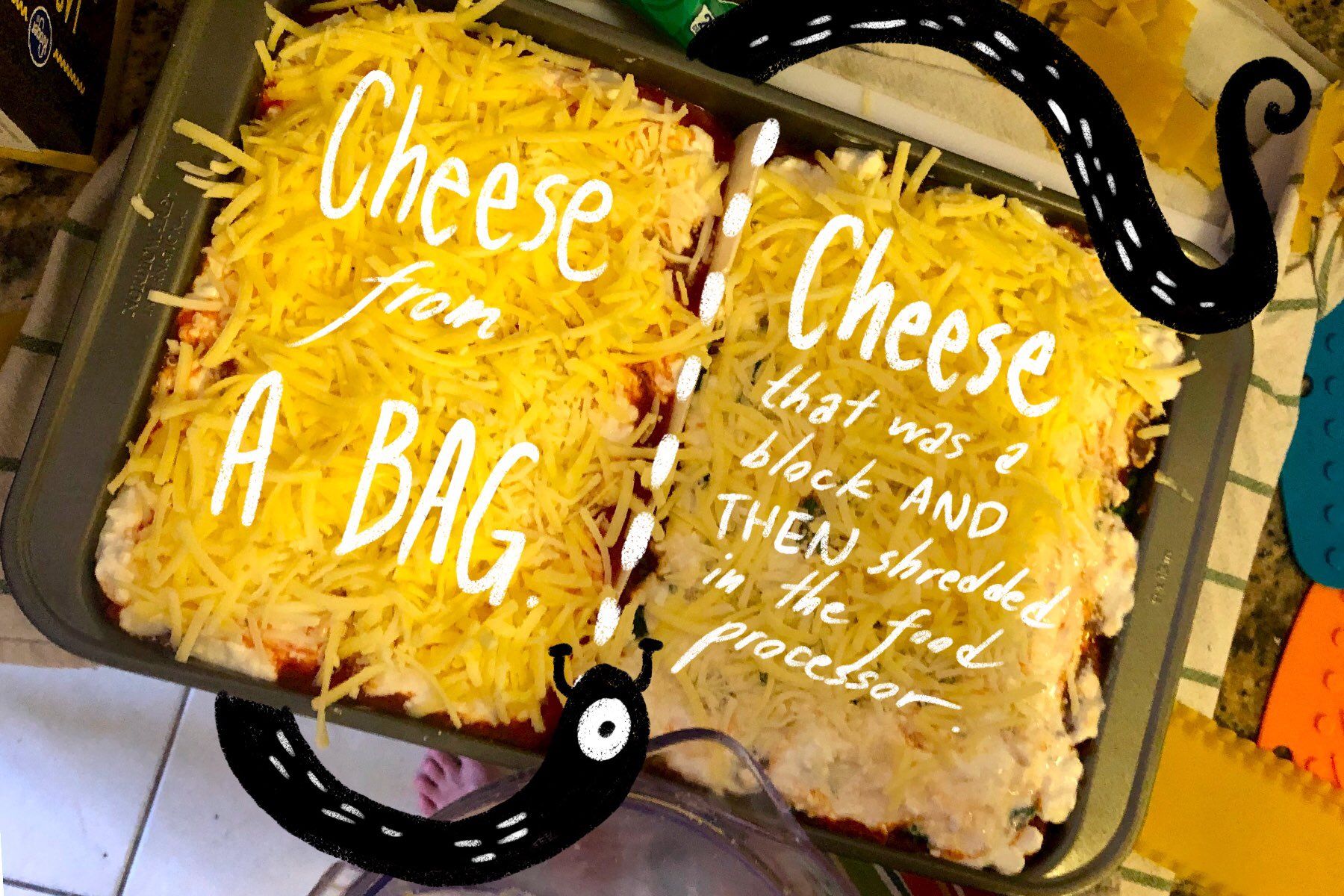
Layers six, seven, eight, and nine repeat: noodles, sauce & stuff, cottage cheese, cheese.
If you're like me and you're using a cake pan instead of a lasagna pan, this lasagna will not look like it's fitting in the pan. The last layer of cheese will rise above the lip of the pan, and you'll feel stressed about it. Don't worry. I'll keep your oven safe.
Layer ten is grated parmesan.
Yes, on top of the cheese layer. This is a lot of cheese. It's a lasagna. You knew what you were getting into. The parmesan is crucial, because it will melt and then brown, forming the most luxurious cheese-crust you've ever seen in your damn life.
- For easy lasagna, use the pre-shredded parmesan. Do not use the powdered stuff in the can - it's made from different ingredients (including wood pulp and parmesan rind) and it won't melt the same. That's why it's so great on pizza: it stays completely distinct from the cheese on the pizza. You don't want that result here, so just buy a bag of milk sprinkles.
- To make it a little more labor-intensive, grate your own parmesan.
I actually prefer the pre-shredded parmesan to fresh-grated in this instance and this instance only. I have two reasons for this preference. First, it's a little more dry, which makes it brown up nicely with almost no puddled grease left on top of the cheese-crust. Second, pre-shredded parmesan has a much less intense flavor than the fresh stuff, especially if you're buying any kind of authentic fresh cheese to shred. While that intense Parmigiano-Reggiano flavor is usually a big plus, especially in creamy sauces, it can overwhelm the lasagna to the point that eating more than a couple of bites is difficult.
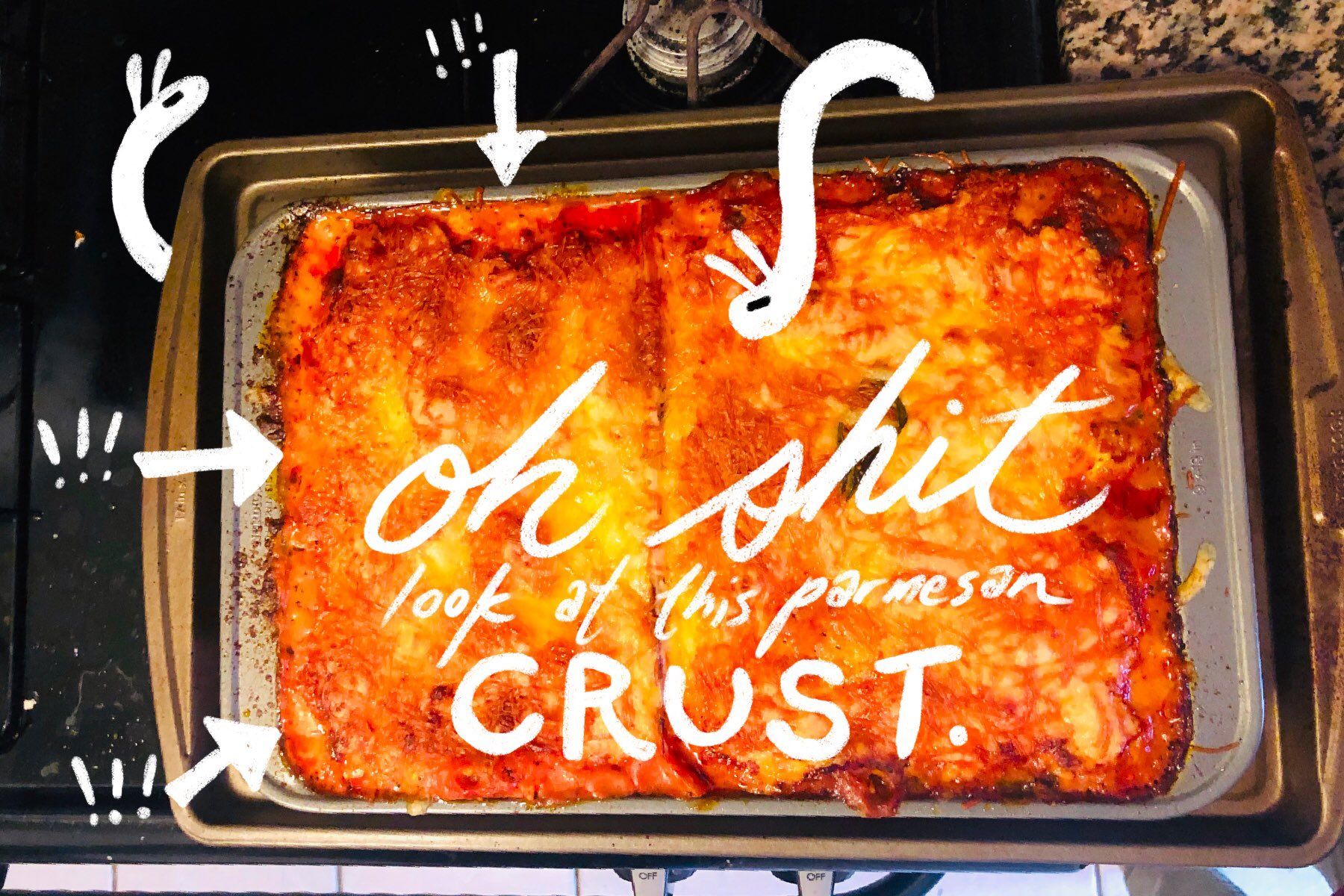
That's it! You did it! Great job!
Put a sheet pan with a 1"-lip on it into the oven and put your pan of lasagna on top of that. This will prevent any spillage from destroying the inside of your oven. Bake for 45-55 minutes, until the top of the lasagna is a deep golden-brown. Cool for 15-20 minutes to avoid destroying your mouth with cheese magma, and to let the lasagna firm up a bit so you can cut it into tidy slices.
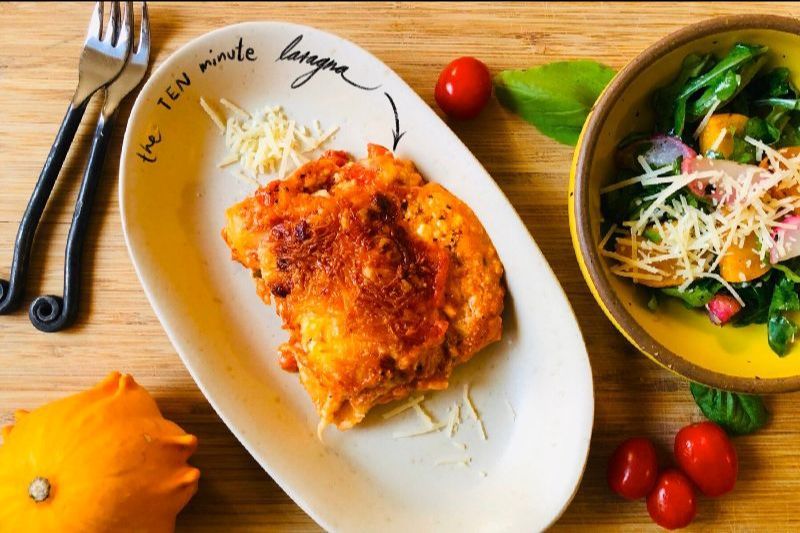
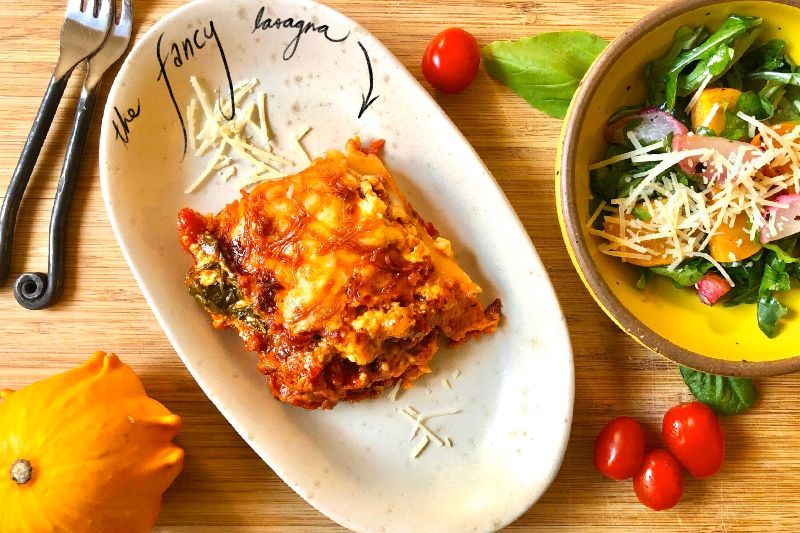
The result of this experiment revealed that different lasagna styles have different strengths. Across the board, my intrepid tasters said that the more complex lasagna (with homemade sauce, beef and vegetables added, and hand-grated cheese) was more complex and delicious, but a little overwhelming; they said that it tasted "restaurant-y," and declared it too flavorful to eat on its own for dinner. The ten-minute-version, on the other hand, was "simple but homey," and had the feel of a perfect weeknight dinner. It holds up well as the only thing on the plate, and it's easy to eat a lot of, so you don't have to think about serving it with sides that can bolster the meal without dominating the palate.
You made it to the bottom of the newsletter! Great job! Here's your recipe for Ten-Minute-Prep Lasagna:
Preheat your oven to 375°F and get out a 9"x13" lasagna pan.
Ingredients:
- 3 lbs jarred pasta sauce (Prego or Classico are good ones)
- 1 box dry lasagna noodles
- 32 oz full-fat cottage cheese
- 1 lb Italian Blend shredded cheese
- 8 oz pre-shredded parmesan cheese
Layer the ingredients in the pan in the following order, from bottom to top:
- A little pasta sauce, just enough to coat the bottom of the pan
- Dry noodles, slightly overlapping
- Half of the remaining pasta sauce
- Half of the cottage cheese
- Half of the Italian Blend shredded cheese
- Dry noodles, slightly overlapping
- All remaining pasta sauce
- All remaining cottage cheese
- All remaining Italian Blend
- Top generously with shredded parmesan
Bake 45-55 minutes, until the top is a rich golden-brown and the edges are bubbling. Cool 15-20 minutes before serving.






Member discussion